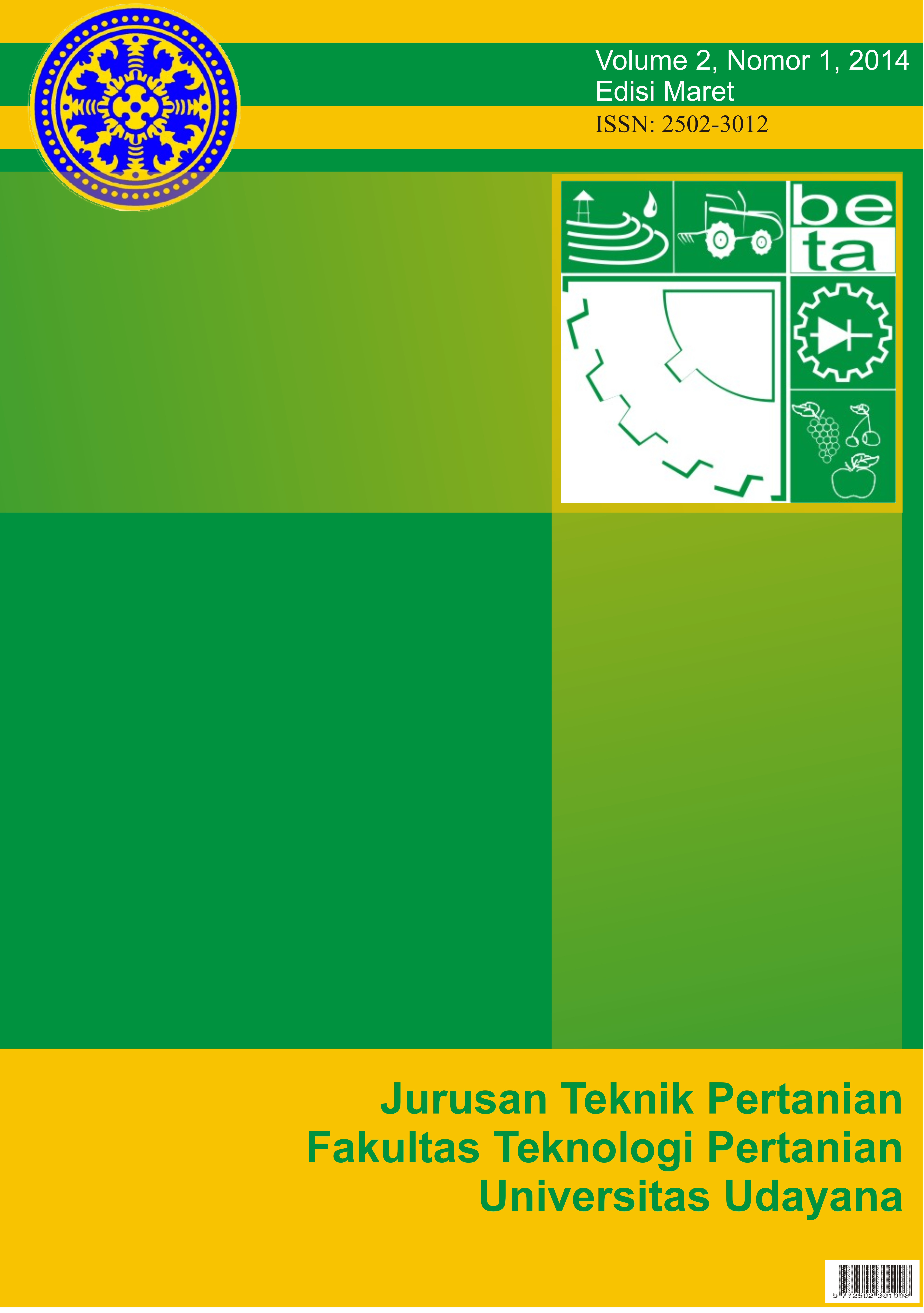Pengaruh Teknik Budidaya SRI (System of Rice Intensification) dan Legowo Terhadap Iklim Mikro dan Produktivitas Padi Ketan (Studi Kasus di Subak Sigaran)
Abstract
This study was conducted to determine the effect of planting System of Rice Intensification (SRI) and legowo 6:1 row planting system of the microclimate and the rice plants productivity. This study was divided into 4 treatments with 3 replications, ie treatments conventional techniques, SRI method of planting, application of legowo 6:1 row planting system, and combination of SRI planting method and legowo 6:1 row planting system. The results showed the application of SRI planting method and legowo 6:1 row planting system not affecting the microclimate conditions, but affecting the productivity of rice
plants. The results also showed that treatment K3 applying SRI methods combined with legowo 6:1 row planting system is the best treatment compared with other treatments.
Downloads
References
Anonimus. 2000. Buku Pedoman Pengamatan Meteorologi pada pos Kerjasama. Departemen Perhubungan Badan Meteorologi dan Geofisika. Jakarta.
Arafah, 2006. Kajian Usahatani Padi dengan Metode Pengelolaan Tanaman Terpadu Pada berbagai Varietas Unggul Baru di Kabupaten Takalar Sulawesi Selatan. Prosd. Seminar Hasil-Hasil Penelitian dan Pengkajian Spesifik Lokasi. Akselerasi Pemasyarakatan Inovasi Teknologi Pertanian Mendukung Revitalisasi Pertanian. Balai Pengkajian Teknologi Pertanian Sulawesi Selatan Makasar.
Gardner, 1991. Fisiologi Tanman Budidaya. Terjemahan oleh H, Susilo. Universitas Indonesia Press. Jakarta.
Hatta, M. 2012. Uji Jarak Tanam Sistem Legowo Terhadap Pertumbuhan Dan Hasil Beberapa Varietas Padi Pada Metode Sri. Staf Pengajar Program Studi Agroteknologi Fakultas Pertanian Unsyiah, Banda Aceh
Husna, Y. 2010. Pengaruh Penggunaan Jarak Tanam Terhadap Pertumbuhan dan Produksi Padi Sawah (Oryza sativa L.) Varietas IR 42 dengan Metode SRI (System of Rice Intensification). Jurnal. Jurusan Agroteknologi. Fakultas Pertanian. Universitas Riau.
Irianto, Wasis Sugeng Yuli. 2008. Ilmu Pengetahuan Alam. Departemen Pendidikan Nasional. Jakarta.
Kuswara, E dan Alik, S. 2003. Dasar Gagasan dan Praktek Tanaman Padi Metode SRI (System Of Rice Intensification) KSP Mengembangkan Pemikiran Untuk Membangun pengetahuan Petani . Jawa Barat.
Mutakin, Jaenal. 2012. Budidaya dan Keunggulan Padi Organik Metode SRI (System of Rice Intensification). http://www.mb.ipb.ac.id/artikel/view/id/html. Terakhir diakses tanggal 13 April 2014.
Sangadji, Sunan. 2001. Pengaruh Iklim Tropis di Dua Ketinggian yang berbeda terhadap Potensi Hasil Tanaman soba. Tesis. Fakultas Pasca Sarjana – IPB. Bogor.
Sohel M. A. T., M. A. B. Siddique, M. Asaduzzaman, M. N. Alam, & M.M. Karim, 2009. Varietal Performance of Transplant Aman Rice Under Diff[e]rent Hill Densities. Bangladesh J. Agril. Res. 34(1): 33 – 39. Diakses 10 April 2014.
Suhendra, T. 2008. Peran Inovasi Teknologi Pertanian dalam Peningkatan Produktivitas Padi Sawah untuk Mendukung Ketahanan Pangan. Prosiding Seminar Nasional Teknik Pertanian, Yogyakarta, 18-19 November 2008.












 Jurnal BETA (Biosistem dan Teknik Pertanian)
Jurnal BETA (Biosistem dan Teknik Pertanian)


